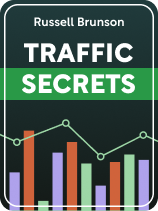

This article is an excerpt from the Shortform book guide to "Traffic Secrets" by Russell Brunson. Shortform has the world's best summaries and analyses of books you should be reading.
Like this article? Sign up for a free trial here.
Are you struggling to attract customers to your online business? Do you want to learn how to effectively drive traffic to your website?
In his book Traffic Secrets, Russell Brunson shares strategies for identifying and reaching your ideal customers online. He offers practical advice on using social media, search engines, and affiliate programs to boost your visibility and sales.
Keep reading to discover Brunson’s proven techniques for growing your online presence and turning visitors into loyal customers.
Overview of Traffic Secrets (Russell Brunson)
In Traffic Secrets, Russell Brunson lays out tips and tricks for driving traffic—potential customers—to your online business. He writes that it’s not enough to merely establish an online presence—what matters is making sure the right people see it: potential clientele who are interested in what you offer and are ready to engage.
Brunson is the co-founder of ClickFunnels, a digital marketing company that’s aided thousands in honing their digital strategy. Traffic Secrets is the third in his series detailing his techniques: In DotCom Secrets, he introduced sales funnels (a series of repeatable steps that lead potential customers along a journey to a sale), in Expert Secrets he explored funnels in greater detail, and in this third installment (published in 2020), he outlines how to increase traffic into your funnels.
We’ll outline Brunson’s advice for identifying potential customers, enticing them to visit your website, getting them to stay, and securing their purchase. We’ll look at his recommendations for using social media platforms, search engines, and affiliate programs to help you.
Find Your Dream Customers
The first step, Brunson writes, is identifying and understanding your dream customers. When you understand what makes your customers tick, you can gain insight into how to best attract them. Then, every ad, post, or content piece you create can effectively connect with your market because you’ll be able to directly address their specific problems and offer solutions they’ll find valuable—and very likely, you’ll be able to do this better than your competitors.
Who Is Your Dream Customer?
According to Brunson, identifying your dream customer isn’t just about defining a general demographic. You have to dig deep and understand who your customer really is. What do they value? What challenges do they face? How can you solve their problems or fulfill their needs?
Brunson recommends creating a customer avatar: an imaginary yet detailed portrait of your ideal customer that describes their age, interests, spending habits, and frustrations. One way to do this is to examine your own experiences: Since you likely created your product or service to solve a problem you yourself had, you may have been your dream customer at one point. If so, think about what you were going through at that time—when you needed a solution like the one you have now. The problems you once had can point you in the right direction now.
Identify Your Dream Customer’s Main Desire
Brunson writes that when assessing your customers, you should start by considering their desires. He argues that when people make purchasing decisions, they’re always trying to satisfy one of these three core desires:
- Health
- Wealth
- Relationships
He emphasizes that all products and services meet one of these needs, and within those needs, people are trying to move away from pain and toward pleasure. To properly flesh out your customer avatar and fully understand your customer, you must determine which of these desires they’re focusing on.
Brunson writes that if your product or service doesn’t fit obviously into one of these categories, or if it fits into more than one, you still have to figure out which one best applies and then focus on that. He uses the example of the razor company Gillette. People he interviewed had trouble identifying which category the company fits into—until they saw its TV ads, which highlight the closeness between a man and a woman made possible by Gillette razors and thus appeal to people’s “relationship” desire.
Find Where Your Dream Customer Hangs Out
Once you’ve identified who your dream customer is and what they want, figure out where they gather online. Brunson notes that the internet has opened up avenues to find your dream customer that didn’t exist in past years because it’s created spaces where people who share interests can easily find each other without geographical restrictions. If you can locate shared spaces full of people interested in products or services like yours, you’ve got an easy target market of potential customers.
Brunson writes that to find these online groups, figure out which of the following your dream customer visits or follows:
- Websites
- Forums and message boards
- Influencers
- Podcasts
- Email newsletters
- Blogs
Narrow in on Your “Dream 100”
Brunson writes that the next step, after you’ve figured out where your dream customer hangs out, is connecting with them both efficiently and effectively:
- Efficiently: Draw in many people’s attention at once, so that you get a good return on your time and energy.
- Effectively: Come across with authority and credibility, so that people don’t ignore you.
To accomplish both goals, Brunson advises that you zero in on what he calls the “Dream 100”: influencers who lead the online communities your dream customer frequents. If you can convince those leaders to promote your product to their followers, you’ll be able to make far more sales than if you tried to reach those followers yourself.
Create Your “Funnel”
Brunson then outlines how you can attract your dream customers into your online sales funnel and guide them toward purchasing your products or services. He advises crafting valuable offers that resonate with the needs and desires you’ve identified for your ideal customer, then incorporating them into an easily navigable web page.
Use a “Hook, Story, Offer” Framework
To draw customers into your sales funnel, you need something to pique their interest, something to engage them further, and finally, something to clinch their purchase: what Brunson calls a hook, story, and offer:
- Hook: an image or headline that grabs people’s attention. It will be something that will prompt them to stop scrolling their social media feeds and instead click for more information.
- Story: a description of something that happened (related to a problem your audience shares) that builds a connection with them.
- Offer: the product or service you’re offering as a solution to their problem.
The detailed avatars you created earlier will be useful now—they’ll guide you in creating a hook, story, and offer that appeal to your particular target market.
Create or Find Distribution Channels
After identifying your customer and creating engaging content to attract them, the next step is creating or finding distribution channels through which you can reach your audience. Brunson advises two approaches: building your own list of email addresses and collaborating with others (affiliates) who already have strong networks in place.
Build Your Email List
Brunson writes that the key to financial success is owning a list of contact information of potential customers. A list of leads can generate easy revenue—imagine, he explains, emailing 10,000 people to offer a $50 product. If just 1% of them respond (100 people), you might quickly earn $5,000. Brunson emphasizes that this is a far more efficient way to make money than working for an hourly wage—if you earned $50 an hour, you’d have to work 100 hours to earn what your list might have made after you spent just half an hour crafting an email.
Brunson advises you to entice people to give you their email address by offering them something free. He describes three types of free offers he’s found effective in convincing people to give them their contact information:
- Lead magnet: Something they can download in exchange for their email address. This will often be something informational, like an e-book.
- Free book: A physical copy of a book, free except for shipping costs.
- Webinar: An online class, if you offer one.
Offering one of these freebies will not only earn you contact information, it can also lead to additional sales—for example, the person who receives the free book or attends the free webinar might then purchase something else from you. But even if it doesn’t lead to additional sales immediately, your giveaways help nurture trust between you and your customer and help build your relationship with them.
Use Affiliate Programs
In addition to using your own distribution channel—the email list you’ve created—Brunson recommends you also tap into other people’s distribution channels by building a strong affiliate network: In every market, there are creators, publishers, and marketers who’ve built up their distribution channels—email lists, followers on social media sites like Facebook and LinkedIn, subscribers to podcasts, and so on. You can jump-start your business by engaging the leaders of those distribution channels to tell their followers about your product. In this way, those leaders become what Brunson calls your “affiliate army.”
Buy Ads
The simplest way to take advantage of affiliate lists is to purchase ads that the creator sends to their followers. These ads can bring you fast results: Typically within 12-48 hours of the email, you’ll see increased traffic on your site. However, Brunson cautions that these ads typically have a short window of effectiveness and that your increased traffic will quickly die down. Thus, you should weigh the cost of such ads against the benefits of spending your marketing money elsewhere.
Partner With Creators
Another way to tap into other distribution lists is to partner with those creators to promote your product, and then pay them a commission for the sales they make for you. There are advantages to this approach: First, it results in a more sincere and enthusiastic promotion of your product. Second, it takes the financial risk off you—instead of paying for ads and hoping they produce sales, you only pay for sales after they’re made.
Train Your Affiliates
You may need to create detailed training programs for your affiliates that show them how best to promote your product. This will address two potential problems:
- If your affiliate is successful and popular, they tend to be less willing to put effort into your product.
- If they’re newer to the industry, they’re typically willing to put in more effort, but they’re often less effective because of their lack of experience and contacts.
In either case, a training program that makes your sales process clear and easy will enable them to become more effective in positioning and selling your product.
Use the Internet Effectively
Brunson’s advice applies mostly to online ventures, and as such, he explores some specific ways you can use the internet as a tool to drum up business. We’ll look at two he focuses on: social media sites and search engines (in particular, Google).
Using Social Media Platforms
Brunson explores how you can effectively leverage various social media channels for maximum exposure and to pull more potential customers into your business funnel. He provides a number of recommendations:
- Use a variety of platforms
- Post frequently
- Don’t “sell” users at first
- Use call-to-action buttons
Use a Variety of Social Media Channels
Brunson writes that each platform has a different focus and offers different opportunities, so he advises that you tailor your content to each one so as to take advantage of their unique characteristics and audiences. By considering each platform’s idiosyncrasies, you can create consistently engaging content for your target customers.
He acknowledges that there are many different platforms you can use, but he mentions a few particularly influential ones you shouldn’t ignore:
- Instagram: an image-based platform ideal for visual storytelling—especially useful for products or services that have visually appealing elements
- Facebook: useful for targeted ads that allow business owners to reach potential customers based on likes, interests, and other demographics
- YouTube: the second largest search engine after Google, and the only platform where content can grow over time—videos don’t fall to the bottom of feeds like in other platforms, but instead can collect more and more views
Brunson advises that you aim for consistent branding across all channels you post on: Use the same logos, color schemes, and tones. This will make it easier for your customers to recognize you anywhere online.
Additionally, he encourages repurposing existing content across different formats—converting blog posts into podcasts or videos, for instance. This not only extends accessibility but can expose your message to fresh new audiences, ensuring that more streams of traffic head toward your business funnel.
Post Frequently
Brunson advises that you post content frequently on social media because it’s only when people see you a number of times that they’ll be compelled to investigate you further. He cautions, though, against posting incessantly because that can overwhelm your followers and lead them to tune out or unfollow you.
He also recommends engaging personally when possible by replying to comments and messages. This lends a human quality to your brand that potential customers respond well to.
Don’t “Sell” Until Users Visit Your Website
Brunson compares social media to a party—it’s a place to make friends, but not to overtly sell your wares (or you’ll be the least popular person at the party).
However, once you’ve made friends by interacting with people, you can metaphorically invite them over to your “house” (your website) by getting them to click on a link. Once they’ve chosen to enter your space, it’s appropriate to try to sell them something.
Use Call-to-Action Buttons
Brunson says that you must include a call-to-action (CTA) button on all of your posts. These are buttons that prompt visitors to take a next step—whether it be to visit your website, enter your sales funnel, or even just indicate that they “liked” your post. These work best when worded clearly but enticingly—think “grab yours” or “start saving,” instead of a more standard “submit.”
The advantage of CTA buttons is that not only do they prod visitors to become customers or to join your email lists, but they also help the algorithms of social media platforms know when people are connecting with your content. The algorithms will then reward your posts with greater exposure.
Using Google
Brunson writes that you must make sure your website ranks highly in Google searches related to your product. Online searches are one of the primary ways people seek out solutions to their problems, so if your site doesn’t pop up in their search results, they can’t become customers. Such a lack of visibility can mean the difference between financial success or failure.
Brunson warns against trying to trick Google’s algorithm by doing things like paying spam sites to link to your website to increase the appearance of backlinks (other websites linking to your site to indicate your site is useful or popular). Even if you happen upon a technique like this that seems to work, Google changes its algorithms regularly to stay ahead of such tactics, and you may find the search engine punishes you (reducing your visibility) for trying to game it.
Analyze Keywords
Brunson says that instead of trying to trick Google’s algorithm, you should publish quality content that’s specifically designed to bring value to your customers, which is what search engines are ultimately trying to provide their users. As you do so, you can increase the searchability of your content by comparing it to content from existing websites. Start by analyzing keywords:
1. Make a list of the keywords and phrases your dream customer will use to look for a product like yours. Also identify the long-tail keywords associated with these primary keywords—phrases that build on these initial ones that often show up in the Google search bar as you type your keyword. For example, if your dream keyword is remodeling, your long-tail keywords might include remodeling ideas, remodeling kitchen, remodeling contractors, and so on.
2. Do some searches using the keywords you identified to find what websites are currently showing up at the top of those rankings.
3. On your website, publish an article that is similar to the articles that are ranking high on your search but that improves on them. You might do this by publishing a longer article (for example, if the article you’re emulating is “20 Best Vacation Spots,” publish a “50 Best” article). Or, you may write one that’s more updated, more detailed, or better-looking. For best results, improve on all four of these aspects. This is called the “skyscraper” technique, as you’re trying to build a website more visible than others around you.
Be sure to include your keywords in your article.
4. Figure out what websites are linking to the sites showing up high in your keyword searches. Contact these other sites and ask them if they’d link to your article as well, since yours is similar but better: longer, more updated, more comprehensive, and better laid-out.
5. Further increase backlinks to your article by promoting it on all the social media sites you use, in your email list, and on any guest posts you make for other peoples’ blogs.
6. In addition to trying to elevate your website’s rank, take advantage of the websites that are already highly ranked within your keywords by purchasing ads on them. Brunson writes that people who find your website by clicking on such an ad are far likelier to turn into paying customers than people who find you through a simple Google search—the fact that they’ve clicked on multiple links to get to you shows they’re more motivated.

———End of Preview———
Like what you just read? Read the rest of the world's best book summary and analysis of Russell Brunson's "Traffic Secrets" at Shortform.
Here's what you'll find in our full Traffic Secrets summary:
- Tips to drive traffic to your online business
- How to find the right customers for your business
- The importance of social media for marketing






